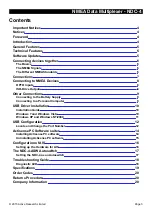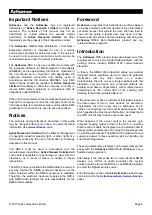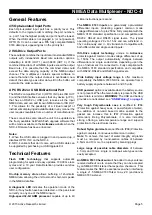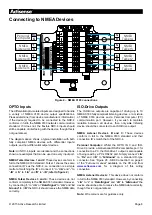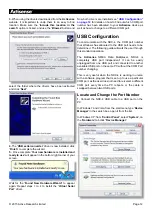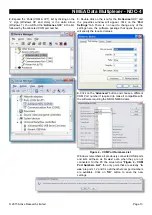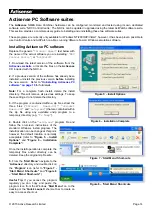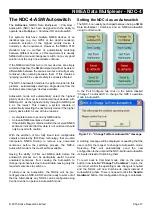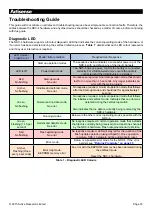
Page 6
© 2015 Active Research Limited
Software Updates
The NDC’s built-in firmware is held in
‘flash’
memory,
allowing quick and easy upgrades using a simple Microsoft
Windows™ NT/2000/XP/Vista/7 user interface program
(ActiPatch) running on a connected PC.
It is our policy to provide these updates free on the
Actisense website (www.actisense.com)
. This upgrade
can be performed with the unit completely in-situ, via a PC
connected to
either
Port 0 (OPTO IN 0 and ISO OUT 0) or
the USB port.
Connecting devices together
The Basics
NMEA data is transmitted from an information source such
as GPS, depth sounder, gyro compass etc. These data
sending devices are called
“Talkers”
.
Equipment receiving this information such as a chart-
plotter, radar or NMEA display is called a
“Listener”
.
Unfortunately, only one Talker can be connected on to a
single NMEA 0183 system at any one time. Two or more
Talkers are simply not possible because they are not
synchronised to each other, and will attempt to ‘talk’ at the
same time (over each other), resulting in corruption of the
NMEA data, and potentially in disaster if valuable data
such as navigation information is lost or corrupted so that
it is incorrect and/or misleading.
Actisense
produces a full range of products to solve all
NMEA interfacing requirements.
Please visit the
Actisense website (www.actisense.
com)
for full details on these and other
Actisense
interfacing, Depth sounding and NMEA 2000 products.
The NMEA Signals
The NMEA 0183 system v2.0 and later uses a ”differential”
signalling scheme, whereby two wires are used to transmit
the NMEA data. These connections will be labelled as
either NMEA
‘A’
and
‘B’
or NMEA
’+’
and
‘-’
respectively,
depending on the instrument and manufacturer.
When connecting between different manufacturers, there
can be some confusion, but it is simple and easy to
remember: NMEA
‘A’
connects to NMEA
‘+’
and NMEA
‘B’
connects to NMEA
‘-’
.
The Different NMEA Standards
The NMEA 0183 specification has slowly evolved over the
years, so connecting one device to another is not always a
straightforward matter. The earlier versions of NMEA 0183
(before v2.0, as detailed above), used slightly different
connection methods and signal levels: the instruments
had just one “NMEA” data line (‘Tx’ or ‘Out’), and used the
ground as the other line - similar to the way a computer
serial port works. This connection method is referred to as
“single ended” instead of the “differential” method used by
NMEA 0183 v2.0 devices.
The data format is largely the same between both systems,
with v2.0 adding some extra sentence strings, and
removing older (redundant) sentence strings from the
specification. The situation is further complicated, as many
manufacturers still use the old (“single ended”) method of
connection because it is cheaper to implement.
So how can an older type NMEA device be connected to a
newer type device?
Care is needed – it is possible to damage or overload the
output of a newer differential device if it is incorrectly
connected to an older device. This is because the older
devices used ground as the return, whereas the newer
devices actually drive the NMEA
‘-/B’
line between 5v and
0v. Thus, connecting this output to ground will result in
high currents being drawn by the driver instrument,
resulting in potential overheating and damage to the driver
circuits.
However, the new
Actisense
ISO-Drive technology allows
the user not to worry about this potentially damaging
incompatibility. Instead, an ISO-Drive output can be
connected to an old type single-ended system, by
connecting the NMEA
‘+/A’
output from the ISO-Drive to
the single-ended NMEA
‘Rx’
or “In” input of the device.
Connect the NMEA
‘-/B’
output of the ISO-Drive to the
ground of the single-ended device. This provides the
required data signal return current path.
To connect an old type single-ended device to an OPTO
IN input, connect the NMEA
‘Tx’
or
‘Out’
output from the
single-ended driver to the OPTO IN
‘+/A’
input of the NDC-
4. Connect the ground line of the single-ended output
device to the OPTO IN
‘-/B’
input of the NDC-4. This
provides the data signal return current path. If the NMEA
‘-/B’
input is left floating, then data corruption / errors may
occur.
Please refer to
“Connecting to NMEA devices” on page
for examples of these connection methods.
Summary of Contents for NDC-4
Page 2: ......



